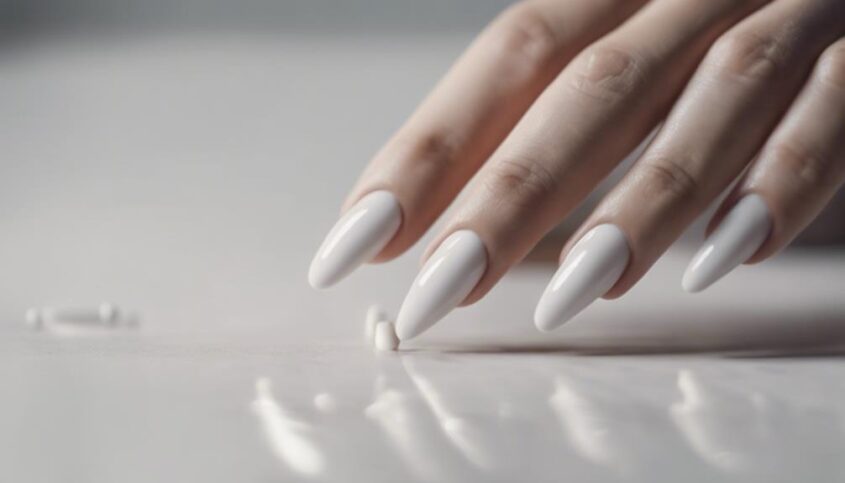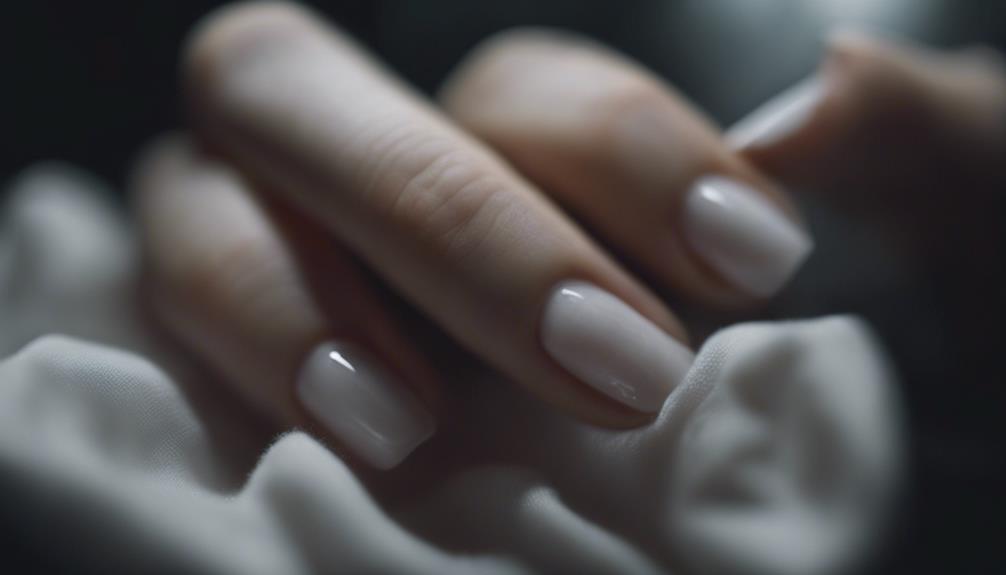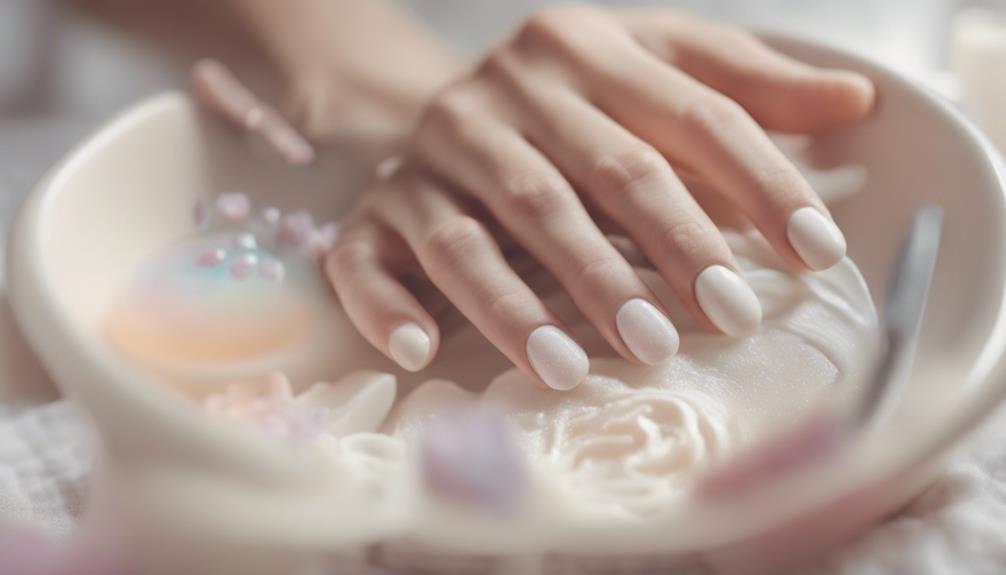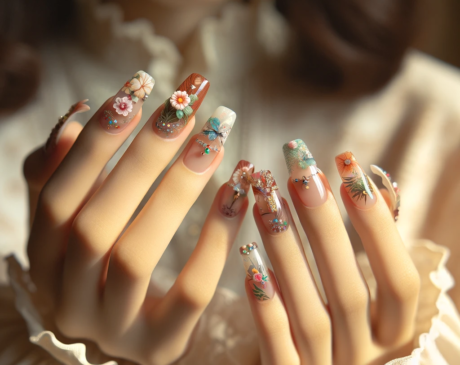What Do White Nails Mean?

White nails can indicate various health issues like nutritional deficiencies, fungal infections, liver or kidney problems, anemia, and heart conditions. If you're concerned about the color of your nails, consulting a healthcare provider is recommended to determine the underlying cause and appropriate treatment options.
Key Takeaways
- White nails can indicate nutritional deficiencies like lack of vitamins and minerals.
- Fungal infections can cause white nails, leading to thickened and brittle nails.
- Liver or kidney issues may be reflected in nail color changes, such as pale or yellow nails.
- Anemia, linked to low red blood cell levels, can manifest as white nails.
- Heart conditions can be suggested by white nails with nail clubbing or specific nail patterns.
Nutritional Deficiencies

Nutritional deficiencies are a common cause of white nails, indicating a potential lack of essential vitamins and minerals in the body. When white spots or streaks appear on the nails, it could be a sign that the body is not receiving an adequate supply of nutrients. In such cases, incorporating dietary changes rich in the necessary vitamins and minerals can help restore nail health. Foods high in biotin, iron, zinc, and calcium are especially beneficial for nail strength and color.
Supplement options can also play a crucial role in addressing nutritional deficiencies that manifest as white nails. Vitamin supplements tailored to promote nail health, such as biotin or multivitamins containing iron and zinc, can be beneficial. However, it is advisable to consult with a healthcare provider before starting any new supplements to ensure they are appropriate for individual needs.
Fungal Infections
Fungal infections can be a common cause of white nails, leading to discoloration and changes in nail texture. Symptoms of fungal infections include thickened, brittle nails that may have a yellow or white hue.
Treatment options for fungal infections range from topical antifungal creams to oral medications prescribed by a healthcare provider.
Causes of White Nails
White nails can often be an indication of fungal infections, which are common causes of this discoloration in nails. Fungal infections can arise due to various medical conditions and have significant health implications.
When fungi invade the nails, they can lead to white spots or discoloration, causing the nails to appear white or yellowish. These infections thrive in warm and moist environments, making nails susceptible, especially if there is a break in the skin.
Individuals with weakened immune systems or conditions like diabetes are at a higher risk of developing fungal nail infections. It is essential to address these infections promptly to prevent further complications and restore the nails' health and appearance.
Symptoms of Fungal Infections
Individuals with fungal nail infections may experience a range of symptoms that signal the presence of this common condition. These symptoms can vary in intensity and presentation, often affecting both the appearance and health of the nails. To identify a possible fungal infection, individuals should look out for the following signs:
- Thickened nails: Fungal infections can cause nails to thicken and become brittle.
- Discoloration: Nails may turn yellow, white, or brown due to fungal growth.
- Brittle or crumbly nails: Infected nails may become fragile and easily break.
- Distorted nail shape: Fungal infections can alter the natural shape of nails, causing them to become irregular.
Maintaining good nail care and hygiene practices is essential in preventing and managing fungal infections.
Treatment Options for Fungi
Effective treatment options for fungal infections include various antifungal medications, topical solutions, and in some cases, oral medications prescribed by healthcare professionals. Topical treatments such as antifungal creams or nail lacquers can be effective in treating mild to moderate fungal infections. Oral medications like fluconazole or terbinafine may be prescribed for more severe cases.
In addition to conventional treatments, some individuals may opt for natural remedies like tea tree oil or vinegar soaks, although their efficacy is not scientifically proven. Another innovative approach is laser therapy, which targets the fungus in the nails without causing harm to the surrounding tissue.
It is essential to consult a healthcare provider for a proper diagnosis and to determine the most suitable treatment plan for fungal infections.
Liver and Kidney Issues
Liver and kidney issues can manifest through various signs, including changes in nail color. When it comes to liver health and kidney function, these vital organs play a crucial role in maintaining overall well-being. Here are some ways in which liver and kidney issues can be reflected in changes in nail color:
- Pale or White Nails: Liver problems such as hepatitis or cirrhosis can lead to pale or white nails due to decreased blood flow or anemia associated with these conditions.
- Yellow Nails: Kidney issues like chronic kidney disease can cause a yellowish discoloration of the nails, known as jaundice, due to the buildup of waste products in the blood.
- Brown Vertical Lines: Liver disease can sometimes result in brown vertical lines on the nails, indicating underlying health issues that need attention.
- Brittle or Crumbling Nails: Kidney problems may lead to brittle or crumbling nails, suggesting a potential imbalance in the body that requires medical evaluation.
Anemia

Anemia is a condition characterized by low levels of red blood cells. It can manifest as white nails, indicating potential health concerns. Iron deficiency is a common cause of anemia, leading to pale nail beds. Poor circulation associated with anemia may also contribute to the development of white nails.
This grouping organizes the information on anemia, its relationship to white nails, and the potential causes in a more coherent and structured manner.
Iron Deficiency
Iron deficiency, a common nutritional deficiency, can lead to various health complications if not addressed promptly. When it comes to iron levels, blood tests are crucial in diagnosing this deficiency.
Here are four innovative ways to address iron deficiency:
- Iron-Rich Diet: Incorporate foods like leafy greens, red meat, and fortified cereals to boost iron levels.
- Supplements: Consider iron supplements under medical supervision to meet daily iron requirements.
- Cooking Techniques: Use cast-iron cookware to increase iron content in meals.
- Combination Therapy: Explore combining vitamin C-rich foods with iron sources to enhance iron absorption.
Poor Circulation
Poor circulation, also known as anemia, can have detrimental effects on overall health and well-being due to inadequate oxygen delivery to tissues and organs. This condition can manifest in various ways, such as cold hands and numbness and tingling sensations in the extremities.
Cold hands are often a result of reduced blood flow to the hands, leading to a drop in temperature in these areas. Numbness and tingling, on the other hand, occur due to the lack of oxygen reaching the nerves, causing abnormal sensations.
Addressing poor circulation promptly is crucial to prevent further complications and improve overall health. Seeking medical advice and incorporating lifestyle changes can help manage anemia and its associated symptoms effectively.
Heart Conditions
Heart conditions can sometimes manifest as changes in the color or texture of the nails, including white discoloration. When examining white nails in relation to heart health, it's essential to consider the following:
- Nail Clubbing: In some cases, white nails accompanied by nail clubbing, where the tips of the fingers enlarge and the nails curve around the fingertips, can indicate underlying cardiac issues.
- Terry's Nails: This condition presents as white nails with a characteristic brown band at the tip. Terry's Nails have been associated with conditions affecting the heart and liver.
- Half and Half Nails: Also known as Lindsay's Nails, this condition displays white nails on the upper half and normal color on the lower half. Half and Half Nails can be a sign of cardiac health problems.
- Muehrcke's Lines: These are paired white lines that appear parallel to the lunula (the white half-moon shape at the base of the nail). They have been linked to issues related to blood circulation and may warrant further cardiac evaluation.
Possible Treatment Options

When considering white nails as potential indicators of underlying health issues, exploring possible treatment options becomes a crucial step in managing related conditions effectively. Nail care and prevention play a significant role in addressing white nails. Maintaining proper nail hygiene, keeping nails dry and clean, and avoiding harsh chemicals can help prevent discoloration. Additionally, ensuring a balanced diet rich in vitamins and minerals essential for nail health can promote overall nail wellness.
Cosmetic solutions and remedies are also available for individuals looking to address white nails for aesthetic purposes. Nail polish and nail brightening products can help conceal the discoloration temporarily. However, it is essential to address the root cause of white nails for long-term improvement. Consulting with a healthcare provider or a dermatologist can help determine the underlying issue and provide personalized treatment recommendations.
Frequently Asked Questions
Can White Nails Be a Sign of a Serious Medical Condition?
White nails can be indicative of serious medical conditions. White nails, along with skin cancer, may suggest underlying health issues. Additionally, white nails can signal a potential vitamin deficiency, emphasizing the importance of monitoring nail health.
Is It Possible for White Nails to Be Hereditary?
Genetic inheritance can influence white nails, with familial traits impacting nail color. In some cases, hereditary factors play a role in determining the appearance of nails, including the presence of white discoloration.
Are There Any Lifestyle Factors That Can Cause White Nails?
Lifestyle factors such as dietary habits, hygiene practices, exposure to environmental factors, and certain medications can contribute to the development of white nails. Understanding these influences can help individuals maintain healthy nail appearance.
Can Stress or Anxiety Contribute to White Nails?
Stress management and anxiety relief are crucial aspects of overall well-being. While stress can manifest in various physical symptoms, including changes in nail appearance, addressing these underlying issues through self-care practices is essential for optimal health.
How Common Are White Nails in Children?
In the realm of pediatric dermatology, the prevalence of white nails in children is a rare occurrence, reflecting exceptional nail health. Such occurrences serve as gentle reminders of the resilience and adaptability present in youthful bodies.
Conclusion
In conclusion, white nails can signify various underlying health issues such as nutritional deficiencies, fungal infections, liver and kidney problems, anemia, and heart conditions. It is important to consult a healthcare professional for proper diagnosis and treatment.
Just as white nails can be a warning sign of hidden dangers lurking beneath the surface, they serve as a reminder to pay attention to our bodies and address any potential health concerns promptly.




